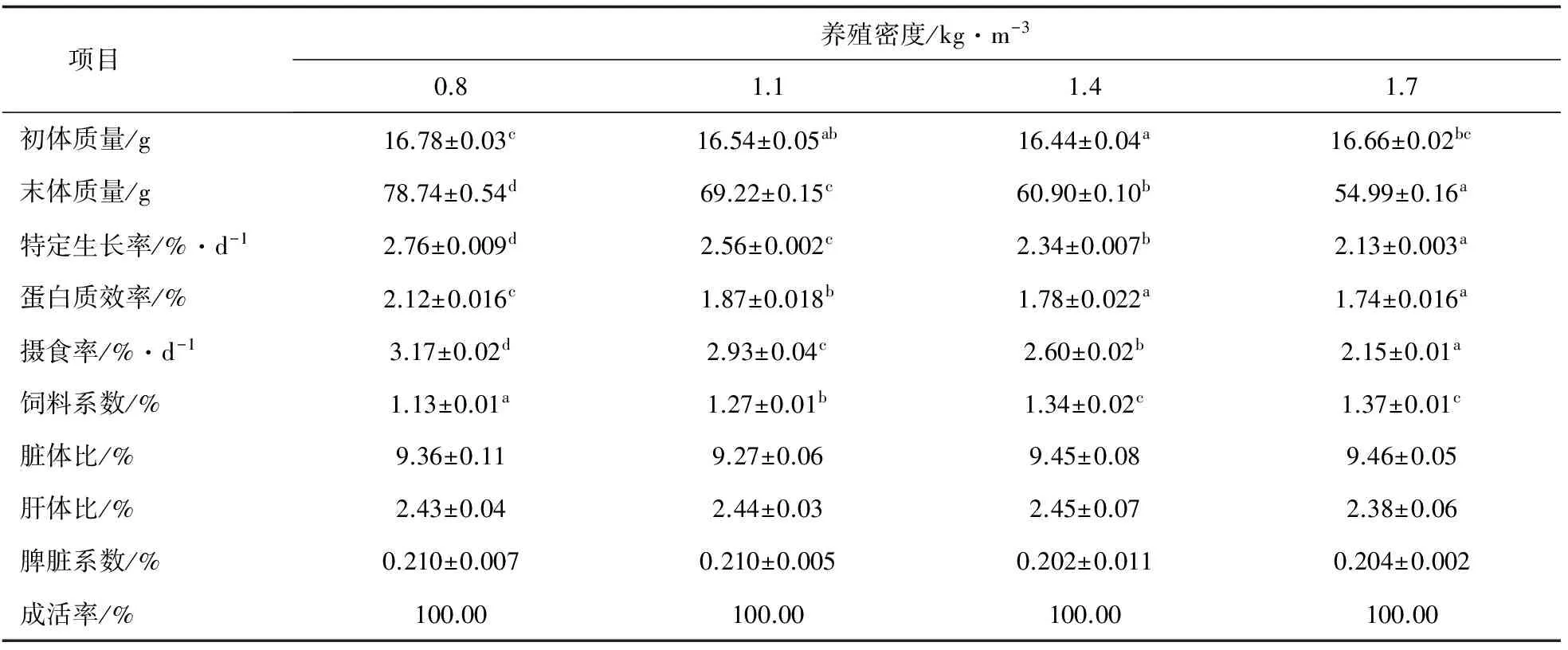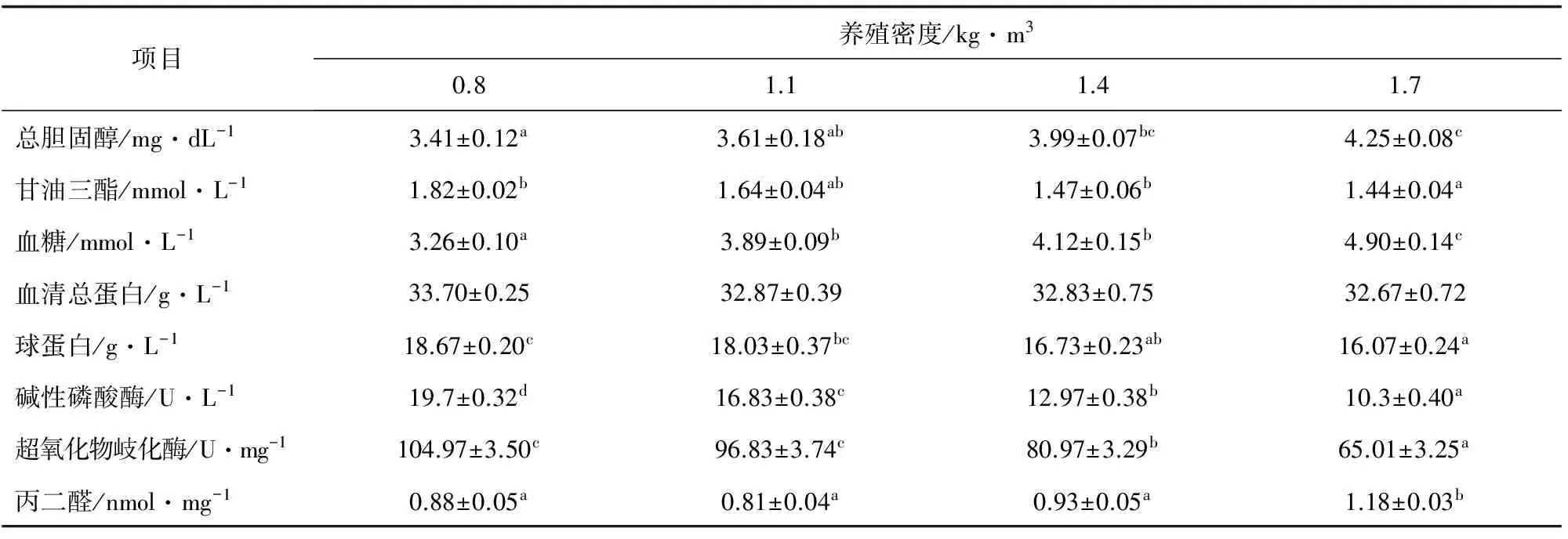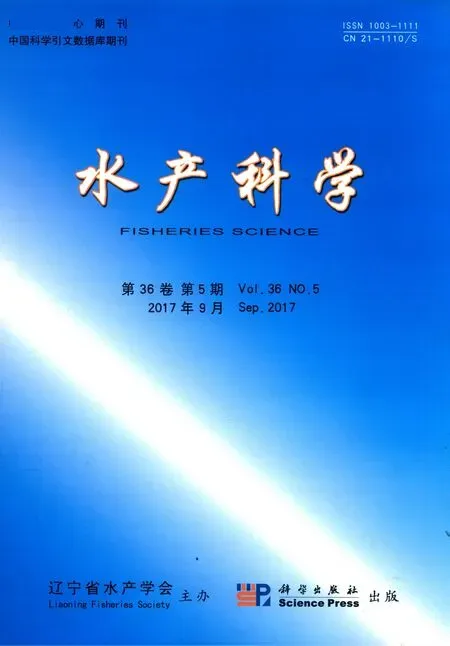养殖密度对杂交鳢生长和生理指标的影响
2017-12-18吴晓清马卉佳高胜男陈拥军林仕梅
吴晓清, 马卉佳, 高胜男, 陈拥军, 林仕梅
( 1.重庆市水产技术推广站,重庆 401147;2.西南大学 动物科技学院,淡水鱼类资源与生殖发育教育部重点实验室,重庆 400715 )
养殖密度对杂交鳢生长和生理指标的影响
吴晓清1, 马卉佳2, 高胜男2, 陈拥军2, 林仕梅2
( 1.重庆市水产技术推广站,重庆 401147;2.西南大学 动物科技学院,淡水鱼类资源与生殖发育教育部重点实验室,重庆 400715 )
设置0.8、1.1、1.4、1.7 kg/m34个养殖密度,研究放养密度对杂交鳢[均质量为(16.5±0.5) g]生长和生理指标的影响。60 d的饲养表明,随着养殖密度的增加,杂交鳢的终末体质量、摄食率、特定生长率和蛋白质效率显著降低,而饲料系数显著升高(P<0.05)。杂交鳢红细胞数随放养密度的增加而显著升高(P<0.05),而白细胞数无显著变化(P>0.05)。0.8 kg/m3密度组血红蛋白含量显著低于其他试验组(P>0.05)。随着放养密度的增加,血清总胆固醇和血糖含量显著升高(P<0.05),而甘油三酯、球蛋白含量以及碱性磷酸酶和超氧化物歧化酶活性显著下降(P<0.05)。各试验组血清总蛋白含量无显著变化(P>0.05)。1.7 kg/m3密度组血清丙二醛含量显著高于其他密度组(P<0.05)。总之,高密度养殖对杂交鳢生长、摄食和代谢产生不利的影响。
杂交鳢;养殖密度;生长;生理指标
我国有限的土地资源迫使鱼类生产者通过增加放养密度来提高单位水体的产量,以获取更高的养殖效益[1-2]。众所周知,养殖密度是影响鱼类生长[3-4]和品质[5-6]的重要因素。研究表明,不适宜的放养密度会影响养殖鱼类的摄食、生长和饲料转化率,甚至鱼体健康[5,7-8]。而高密度养殖会引起鱼类一系列的生理生化和免疫响应[9],进而影响鱼的摄食和生长[10-12],导致个体间生长差异增大,出现生长级差,甚至还会影响养殖水质[13]。
杂交鳢(Channamaculata♀×C.argus♂)因生长快、抗逆性强、产量高、肉质鲜美等特点,成为我国的经济养殖鱼类。目前,杂交鳢主要采用池塘高密度集约化养殖,产量在45 000 kg/hm2以上,由于养殖技术资料的缺乏,以致诸多问题在生产中凸显出来,如生长、病害、个体均匀等问题。高密度养殖不仅是许多疾病的重要诱因[14],而且还影响鱼的生长性能。为此,本研究探讨了不同放养密度对杂交鳢生长和生理指标的影响,旨在补充和完善其养殖学资料,为杂交鳢的规模化、生态化养殖生产提供依据和技术指导。
1 材料与方法
1.1 试验饲料
以鱼粉和豆粕为主要蛋白源,鱼油和豆油为脂肪源,配制一种生产实用饲料(粗蛋白42%,总能18 MJ/kg)。饲料原料均过80目筛,采用逐级稀释法混合均匀,制成粒径为3.0 mm的膨化浮性颗粒饲料(洋工TSE65S型双螺杆湿法膨化机),风干后放入冰箱中4 ℃保存备用。
1.2 试验设计与饲养管理
设置0.8、1.1、1.4、1.7 kg/m34个密度组,每组设3个重复,在室内循环养殖系统(每个缸的有效容积为3000 L)中饲养杂交鳢[均质量为(16.5±0.5) g] 60 d。试验处理均投喂同一种饲料,日投饲率为体质量的3%~5%,每日08:30、13:30、17:30各投喂1次。水源为曝气自来水,养殖期间水温为(26.5±2.3) ℃,溶解氧>6.8 mg/L,氨氮<0.39 mg/L,pH 7.2±0.3。
1.3 样品制备与分析
养殖试验结束后,禁食24 h称体质量。每缸随机取4尾鱼, 取其内脏、肝脏和脾脏称质量;随机取10尾于尾静脉取血,部分保存于医用真空采血管,用于血液学分析,其余血样4 ℃静置过夜, 3000 r/min 离心10 min后取血清, -80 ℃保存备用。
全血样品经磷酸缓冲液稀释(1∶10000)后, 采用血球计数板统计白细胞数和红细胞数。血红蛋白含量采用试剂盒(南京建成生物工程研究所生产)测定。全血中葡萄糖(血糖)含量采用上海强生血糖仪测定。血清指标采用日立7100生化分析仪测定,包括总胆固醇、甘油三酯、总蛋白、球蛋白含量以及碱性磷酸酶和超氧化物歧化酶活性。血清丙二醛含量采用试剂盒(南京建成生物工程研究所生产)测定。蛋白质含量采用考马斯亮蓝法测定。
1.4 计算公式
摄食率/%·d-1=m1/[t×(m2+m3)/2]×100%
特定生长率/%·d-1=(lnm3-lnm2)/t×100%
饲料系数/%=m1/m4×100%
蛋白质效率/%=m4/m5×100%
脏体比/%=m6/m×100%
肝体比/%=m7/m×100%
脾脏系数/%=m8/m×100%
式中,m1为干物质摄入量(g),m2为初体质量(g),m3为末体质量(g),m4为鱼体净增质量(g),m5为蛋白质摄入量(g),m6为内脏质量(g),m7为肝胰脏质量(g),m8为脾脏质量(g),m为体质量(g),t为试验时间(d)。
1.5 数据处理与分析
采用SPSS 22.0对所得数据进行单因素方差分析,若差异达到显著水平,则进行Tukey多重比较,显著水平为0.05。除成活率外,数据均以平均值和标准差表示。
2 结 果
2.1 放养密度对杂交鳢生长的影响
随着放养密度的增加,杂交鳢的末质量、特定生长率、蛋白质效率和摄食率显著降低,而饲料系数显著升高(P<0.05)(表1)。各试验组脏体比、肝体比和脾脏系数无显著差异(P>0.05)。试验鱼的成活率为100%。

表1 不同放养密度对杂交鳢生长的影响
注:同行肩标不同小写字母表示显著差异(P<0.05),下表同.
2.2 放养密度对杂交鳢血液指标的影响
随着放养密度的增加,杂交鳢红细胞数显著升高(P<0.05),而白细胞数无显著变化(P>0.05)(表2)。0.8 kg/m3密度组血红蛋白含量显著低于其他试验组(P>0.05),其余密度组血红蛋白含量无显著差异(P>0.05)。

表2 养殖密度对乌鳢血液学指标的影响
2.3 放养密度对杂交鳢血清生化指标的影响
随着放养密度的增加,血清总胆固醇和血糖含量显著升高(P<0.05),而甘油三酯、球蛋白含量以及碱性磷酸酶和超氧化物歧化酶活性显著下降(P<0.05)(表3)。各试验组血清总蛋白含量无显著差异(P>0.05)。1.7 kg/m3密度组血清丙二醛含量显著高于其他密度组(P<0.05)。

表3 不同养殖密度对乌鳢血清生化指标的影响
3 讨 论
3.1 放养密度对杂交鳢生长的影响
本研究发现, 随着养殖密度的增加, 杂交鳢的生长性能显著下降。这与在青石斑鱼(Epinephelusawoara)[1]、大菱鲆(Scophthalmusmaximus)[2]、中华鲟(Acipensersinensis)[15]、虹鳟(Oncorhynchusmykiss)[16]和点篮子鱼(Siganusguttatus)[17]上的研究结果一致。而养殖密度过低,鱼类的生长也会受到抑制作用[4,18]。从已有的研究资料来看,不同的养殖鱼类对密度的响应是有差异的[4,8-9],这表明养殖密度与鱼种、养殖方式和养殖环境密切相关。相反,也有研究指出,放养密度对养殖对象影响较小或几乎没有影响[19-20]。从生长和效益来讲,养殖密度过高或过低对渔业的可持续发展都不利。在不同的养殖方式下,杂交鳢适宜的放养密度还有待深入探讨。
本试验期间,各试验组都保持了良好的水质和较高的溶解氧水平,排除了水质条件对杂交鳢生长的影响,高密度组杂交鳢生长受到抑制的因子可能是拥挤胁迫。当然,养殖密度对鱼类生长的影响不仅仅是水质变化造成的[11]。同时还发现,随着养殖密度的增加,摄食率和蛋白质效率降低,而饲料系数升高。这进一步证实过高的养殖密度降低了杂交鳢对饲料的吸收利用率, 继而影响其生长,类似的文献较多[1-6]。有研究认为,高密度组鱼类摄食率的降低是由于拥挤限制了食物可得性[21]。本试验中杂交鳢采取饱食投喂, 即没有限制对食物的可得性。因此, 高密度养殖条件下鱼类低摄食量可能就是对拥挤胁迫的一种适应[22]。密度过高还会引起鱼类出现一定程度的应激反应[23], 导致机体能耗升高。本研究中, 高密度组血红蛋白含量显著高于低密度组, 也证实了高密度组杂交鳢个体血液的携氧能力提高,新陈代谢相对旺盛,这与此前结果类似[8,11,24]。通常鱼类的应激状况可通过生长受抑制反映出来[25]。由此可见, 高密度组杂交鳢处于拥挤胁迫造成的应激状态,导致摄入的营养物质用于消耗供能的比例偏高[26],饲料利用率降低,从而抑制了鱼的生长。
3.2 放养密度对杂交鳢血液生理的影响
在现代集约化养殖生产中,密度胁迫可引起鱼类生理生化指标及行为学的变化[27],通过血液中生化指标的变化还可了解鱼类的健康与营养状况[28]。在高耗能状态(高密度)下,养殖鱼类通过增加血红蛋白含量和红细胞数量来提高氧的运输能力,这是鱼类的一种生理性适应反应[6,11]。本研究结果也证实,养殖密度能明显增加杂交鳢红细胞的数量。这与在杂交鲟(A.baerii×A.schrenckii)[6]、俄罗斯鲟(A.gueldenstaedtii)[8]、虹鳟[12]和褐牙鲆(Paralichthysolivaceus)[29]上的研究结果一致,而青石斑鱼的红细胞数量却随养殖密度的增加而递减[6]。由此可知, 养殖密度确实引起了鱼类红细胞数量发生了变化, 但是存在种间差异。同时以上结果也表明,在高密度养殖条件下,通过增加血红蛋白的含量来提高红细胞的携氧能力,以满足鱼体生长、代谢对氧的需求。
研究表明, 养殖密度作为鱼类的一种应激因子,通常用皮质醇来评估鱼类应激反应的强度。而血浆皮质醇与血糖水平又密切相关[30],皮质醇通过糖原异生或肝糖原分解途径诱导血糖水平的升高,满足机体对额外能量的需求[31]。因此,血糖被看成是研究鱼类对胁迫适应性的一个重要参数[32]。高密度作为一种重要胁迫因子易引起杂交鳢对额外能量的需求,糖异生作用加强,从而导致血糖水平升高。这与在杂交鲟[6]、虹鳟[12]和欧洲狼鲈(Dicentrarchuslabrax)[33]上的研究结果一致。相反,高密度养殖对欧洲鳇(Husohuso)[34]血糖水平无显著影响。同样,血脂的变化也是反映动物处于应激状况的一个重要特征。已有研究表明,养殖密度会影响欧洲狼鲈[35]和虹鳟[36]血清中甘油三酯和总胆固醇含量。本研究结果也证实了这一点,揭示了鱼体还可通过加速甘油三酯的分解产生应对胁迫所需的能量[37],所以密度越高甘油三酯含量就越低[36]。
3.3 放养密度对杂交鳢免疫和抗氧化能力的影响
研究表明,高密度作为胁迫因子会影响鱼类的免疫和抗氧化能力[38]。本研究发现,高密度组球蛋白和碱性磷酸酶活性显著降低,这在杂交鲟[6]、虹鳟[12]和黄姑鱼(Nibeaalbiflora)[20]上有类似的报道。但高密度引起养殖鱼类免疫参数的变化有差异[23,39]。由此可见,密度胁迫持续作用于养殖鱼类,进而引起机体产生了一系列防御反应, 以应对外界环境的变化。杂交鳢同样也能够通过特异的生理调节来适应高密度胁迫的养殖环境。而环境与生理胁迫又可能对鱼类产生氧化压力,使得机体反应生成大量自由基。鱼体超氧化物歧化酶活性和丙二醛含量的高低间接反映了机体的抗氧化能力[40]。本研究表明, 高密度显著影响杂交鳢血清超氧化物歧化酶活性和丙二醛含量,与俄罗斯鲟[8]的研究结果一致。这表明高密度组鱼体受到拥挤胁迫时, 机体能耗升高, 促进了氧自由基的产生, 导致丙二醛含量升高。高密度组超氧化物歧化酶活性较其他组低, 说明密度过高也可引起机体代谢失衡,造成细胞损伤,降低了机体的抗氧化能力。
[1] 张曦文, 吴垠, 贺茹靖, 等. 循环水养殖模式下养殖密度对青石斑鱼生长及生理指标的影响[J].大连海洋大学学报, 2012, 27(6):518-522.
[2] Li X, Liu Y, Jean-Paul B. Effect of stocking density on performances of juvenile turbot (Scophthalmusmaximus) in recirculating aquaculture systems[J]. Chinese Journal of Oceanology and Limnology, 2013, 31(3):514-522.
[3] Ashley P J. Fish welfare: current issues in aquaculture[J]. Applied Animal Behaviour Science, 2007, 104(3/4):199-235.
[4] 逯尚尉, 刘兆普, 余燕.密度胁迫对点带石斑鱼幼鱼生长、代谢的影响[J].中国水产科学, 2011, 18(2):322-328.
[5] Tolussi C E, Hilsdorf A W S, Caneppele D, et al. The effects of stocking density in physiological parameters and growth of the endangered teleost species piabanha,Bryconinsignis(Steindachner, 1877)[J]. Aquaculture, 2010, 310(1/2):221-228.
[6] 程佳佳, 李吉方, 温海深, 等. 养殖密度对杂交鲟幼鱼生长、肌肉组分和血液生理生化指标的影响[J].中国水产科学, 2015, 22(3):433-441.
[7] Merino G E, Piedrahita R H, Conklin D E. The effect of fish stocking density on the growth of California halibut (Paralichthyscalifornicus) juveniles[J]. Aquaculture, 2007(265):176-186.
[8] 曹阳, 李二超, 陈立侨, 等. 养殖密度对俄罗斯鲟幼鱼的生长、生理和免疫指标的影响[J].水生生物学报, 2014, 38(5):968-974.
[9] Salas-Leiton E, Anguis V, Martín-Antonio B, et al. Effects of stocking density and feed ration on growth and gene expression in the Senegalese sole (Soleasenegalensis):potential effects on the immune response[J]. Fish & Shellfish Immunol, 2010, 28(2):296-302.
[10] Vijayan M, Ballantyne J, Leatherland J. High stocking density alters the energy metabolism of brook charr (Salvelinusfontinalis)[J]. Aquaculture,1990, 88(3/4):371-381.
[11] Montero D, Izquierdo M, Tort L, et al. High stocking density produces crowding stress altering some physiological and biochemical parameters in gilthead seabream,Sparusaurata, juveniles[J]. Fish Physiol Biochem, 1999, 20(1):53-60.
[12] Yarahmadi P, Miandare H K, Hoseinifar S H, et al. The effects of stocking density on hemato-immunological and serum biochemical parameters of rainbow trout (Oncorhynchusmykiss)[J].Aquaculture Int, 2015, 23(1):55-63.
[13] Santos G A, Schrama J W, Mamauag R E P, et al. Chronic stress impairs performance, energy metabolism and welfare indicators in European seabass (Dicentrarchuslabrax):the combined effects of fish crowding and water quality deterioration[J]. Aquaculture, 2010,299(1/4):73-80.
[14] Smith S A, Levy M G, Nogae E J. Communications:detection of anti-Amyloodiniumocellatumantibody from cultured hybrid striped bass (Moronesaxatilis×M.chrysops) during an epizootic of amyloodiniosis[J]. Journal of Aquatic Animal Health,1994,6(1):79-81.
[15] 张建明, 郭柏福, 高勇.中华鲟幼鱼对慢性拥挤胁迫的生长、摄食及行为反应[J].中国水产科学, 2013, 20(3):592-598.
[16] McKenzie D J, Höglund E, Dupont-Prinet A,et al. Effects of stocking density and sustained aerobic exercise on growth, energetics and welfare of rainbow trout[J]. Aquaculture, 2012(338/341):216-222.
[17] 邹雄,章龙珍,张涛,等.养殖密度对点篮子鱼生长性能的影响[J].水产科学,2013,32(10):601-604.
[18] Jorgensen E H, Christiansen J S, Jobling M. Effects of stocking density on food intake, growth performance and oxygen consumption in Artic charr (Salvelinusalpinus) [J]. Aquaculture, 1993, 110(2):191-204.
[19] Celikkale M S, Memis D, Ercan E. Growth performance of junvenile Russian sturgeon (AcipensergueldenstaedtiiBrandt & Ratzenbrug,1983) at two stocking densities in net cages[J]. J Appl Ichthyol, 2005,21(1):14-18.
[20] 薛宝贵, 楼宝, 徐冬冬, 等.密度胁迫对黄姑鱼幼鱼生长、代谢及非特异性免疫的影响[J].渔业科学进展, 2013,34(2):45-51.
[21] Refstie T, Kittelsen A. Effect of density on growth and survival of artificially reared Atlantic salmon[J]. Aquaculture,1976, 8(4):319-326.
[22] Vijayan M M, Ballantyne J S, Leatherland J F. High stocking density alters the energy metabolism of brook charr,Salvelinusfontinalis[J]. Aquaculture, 1990, 88(3/4):371-381.
[23] Yin Z, Lam T J, Sin Y M. The effects of crowding stress on the nonspecific immune response in fancy carp (CyprinuscarpioL.) [J]. Fish & Shellfish Immunol, 1995, 5(7):519-529.
[24] Ruane N M, Carballo E C, Komen J. Increased stocking density influences the acute physiological response of the common carpCyrinuscarpio(L) [J]. Aquaculture Research, 2002, 33(10):777-784.
[25] Pankhurst N W, Van Der Krrak G. Effects of stress on reproduction and growth of fish[G]//Iwama G K, Sumpter J P, Schreck C B. Fish stress and health in aquaculture, Cambrige:Cambrige University Press, 1997:73-93.
[26] Marchand F, Boisclair D. Influence of fish density on the energy allocation pattern of juvenile brook trout (Salvelinusfontinalis) [J]. Can J Fish Aquat Sci, 2011, 55(4):796-805.
[27] Ellis T, North B, Scott A P, et al. The relationships between stocking density and welfare in farmed rainbow trout[J]. Journal of Fish Biology, 2002, 61(3):493-531.
[28] 洪磊, 张秀梅. 环境胁迫对鱼类生理机能的影响[J]. 海洋科学进展, 2004, 22(1):114-121.
[29] 董晓煜, 张秀梅, 张沛东. 溶解氧与养殖密度对褐牙鲆幼鱼血细胞数量及血红蛋白含量影响的研究[J]. 海洋水产研究, 2008, 29(6):40-46.
[30] Almeida J S, Meletti P C, Martinez C B. Acute effects of sediments taken from an urban stream on physiological and biochemical parameters of the neotropical fish (Prochiloduslineatus)[J]. Comp Biochem Physiol C Toxicol Pharmacol, 2005, 140(3/4):356-363.
[31] Vinodhini R, Narayanan M. The impact of toxic heavy metals on the hematological parameters in common carp (CyprinuscarpioL.)[J]. Iran J Environ Health Sci Eng, 2009, 6(1):23-28.
[32] Tejpal C S, Pal A K, Sahu N P. Dietary supplementation of L-tryptophan mitigates crowding stress and augments the growth inCirrhinusmrigalafingerlings[J]. Aquaculture, 2009, 293(3/4):272-277.
[33] Lupatsch I, Santos G A, Schrama J W, et al. Effect of stocking density and feeding level on energy expenditure and stress responsiveness in European sea bassDicentrarchuslabrax[J]. Aquaculture, 2010, 298(1):245-250.
[34] Rafatnezhad S, Falahatkar B, Tolouei Gilani M H. Effects of stocking density on haematological parameters, growth and fin erosion of great sturgeon (Husohuso) juveniles[J]. Aquac Res, 2008, 39(14):1506-1513.
[35] Di Marco P, Priori A, Finoia M G, et al. Physiological responses of European sea bassDicentrarchuslabraxto different stocking densities and acute stress challenge [J]. Aquaculture, 2008, 275(1/4):319-328.
[36] 刘群, 温海深, 李吉方, 等. 网箱养殖密度对虹鳟甲状腺激素及血脂指标的影响[J]. 水生生物学报, 2014, 38(6):1076-1083.
[37] Leatherland J F. Studies of the correlation between stress-response, osmoregulation and thyroid physiology in rainbow trout,Salmogairdnerii(Richardson) [J].Comparative Biochemistry and Physiology Part A:Physiology, 1985, 80(4):523-531.
[38] Hegazi M M, Attia Z I, Ashour O A. Oxidative stress and antioxidant enzymes in liver and white muscle ofNile tilapia juveniles in chronic ammonia exposure [J]. Aquatic Toxicology, 2010, 99(2):118-125.
[39] Cristea V, Mocanu M C, Antache A, et al. Effect of stocking density on leuckocyte reaction ofOncorhynchusmykiss(Walbaum, 1792)[J]. Anim Sci Biotechnol, 2012, 45(2):31-36.
[40] Viarengo A, Canesi L, Martinez P G, et al. Pro-oxidant processes and antioxidant defence systems in the tissues of the Antarctic scallop (Adamussiumcolbecki)
compared with the Mediterranean scallop (Pectenjacobeus) [J]. Comparative Biochemistry and Physiology Part B:Biochemistry and Molecular Biology, 1995, 111(1):119-126.
PhysiologicalResponsesofHybridSnakehead(Channamaculata×C.argus)toDifferentStockingDensities
WU Xiaoqing1, MA Huijia2, GAO Shengnan2, CHEN Yongjun2, LIN Shimei2
( 1.Fisheries Technology Extension Station of Chongqing, Chongqing 401147, China; 2.Key Laboratory of Freshwater Fish Reproduction and Development, Ministry of Education, College of Animal Science and Technology, Southwest University,Chongqing 400715, China )
The effects of chronic crowding stress on growth and physiological indices were studies in juvenile hybrid snakehead (Channamaculata×C.argus). Snakehead [mean body weight of (16.5±0.5) g] were randomly reared at four stocking densities (0.8 kg/m3,1.1 kg/m3,1.4 kg/m3and 1.7 kg/m3) for 60-days with triplicate groups.The results showed that the final body weight, specific growth rate(SGR), feed intake(FI) and protein efficiency rate(PER) were significantly decreased (P<0.05) with the increasing stocking density, but feed conversion ratio (FCR) significantly increased (P<0.05). The level of red blood cells was increased significantly with an increase in stocking density (P<0.05).However, stocking density had no significant effect on the level of white blood cells. The content of hemoglobin (HGB) was significantly (P<0.05) lower in 0.8 kg/m3group than that in other groups.With the increasing stocking density, plasma glucose(GLU) and total cholesterol (TC) increased significantly (P<0.05), but contents of triglyceride (TG) and globin(GLOB), and activites of alkaline phosphatase (ALP) and superoxide dismutase(SOD) decreased significantly (P<0.05). Stocking density had no significant effect on total protein(TP) levels (P>0.05).There was significantly higher content of malondialdehyde (MDA) in 1.7 kg/m3group than in other groups(P<0.05).In conclusion, high stocking density will be harmful to the growth of hybrid snakehead.
Channamaculata×C.argus; stocking density; growth; physiological index
10.16378/j.cnki.1003-1111.2017.05.003
2016-11-11;
2017-01-06.
重庆市现代特色效益农业产业技术体系项目(2016-91).
吴晓清(1972-), 女, 工程师;研究方向:水产养殖技术推广.E-mail: 729464038@qq.com.通讯作者: 林仕梅 (1970-), 男, 副教授;研究方向:水产动物营养与饲料.E-mail: linsm198@163.com.
S965.116
A
1003-1111(2017)05-0557-06
